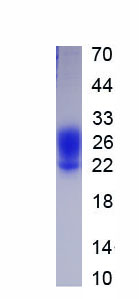Active Interleukin 3 (IL3) 

MCGF; MULTI-CSF; MCSF; M-CSF; Multiple; Multilineage-Colony-Stimulating Factor; Hematopoietic Growth Factor; P-Cell Stimulating Factor; Mast-Cell Growth Factor
- UOM
- FOB US$ 354.00 US$ 885.00 US$ 1,770.00 US$ 5,310.00 US$ 13,275.00
- Quantity
Overview
Properties
- Product No.APA076Ra61
- Organism SpeciesRattus norvegicus (Rat) Same name, Different species.
- ApplicationsCell culture; Activity Assays.
Research use only - DownloadInstruction Manual
- CategoryCytokineInfection immunity
- Buffer FormulationPBS, pH7.4, containing 5% Trehalose.
- Traits Freeze-dried powder, Purity > 95%
- Isoelectric Point8.0
Sign into your account
Share a new citation as an author
Upload your experimental result
Review

Contact us
Please fill in the blank.
Activity test

Interleukin 3 is an interleukin, a type of biological signal that can improve the body's natural response to disease as part of the immune system. It acts by binding to the interleukin 3 receptor. IL-3 synergizes with other cytokines to stimulate the growth of immature progenitor cells of all lineages, and is therefore a multi-lineage colony-stimulating factor (CSF). It prevents cell death and promotes the survival of macrophages, mast cells, and megakaryocytes. IL-3 can also support the growth and survival of myeloid progenitor cells through the activation of Janus Kinase 2 (JAK2) tyrosine kinase, and macrophage differentiation has been shown to be regulated by protein kinase C (PKC). Thus a functional binding ELISA assay was conducted to detect the interaction of recombinant rat IL-3 and recombinant rat JAK2. Briefly, IL-3 were diluted serially in PBS, with 0.01% BSA (pH 7.4). Duplicate samples of 100 ul were then transferred to JAK2-coated microtiter wells and incubated for 1h at 37℃. Wells were washed with PBST and incubated for 1h with anti-IL-3 pAb, then aspirated and washed 3 times. After incubation with HRP labelled secondary antibody, wells were aspirated and washed 5 times. With the addition of substrate solution , wells were incubated 15-25 minutes at 37℃. Finally, add 50 µL stop solution to the wells and read at 450 nm immediately. The binding activity of IL-3 and JAK2 was shown in Figure 1, and this effect was in a dose dependent manner.
Usage
Reconstitute in 10mM PBS (pH7.4) to a concentration of 0.1-1.0 mg/mL. Do not vortex.
Storage
Avoid repeated freeze/thaw cycles. Store at 2-8°C for one month. Aliquot and store at -80°C for 12 months.
Stability
The thermal stability is described by the loss rate. The loss rate was determined by accelerated thermal degradation test, that is, incubate the protein at 37°C for 48h, and no obvious degradation and precipitation were observed. The loss rate is less than 5% within the expiration date under appropriate storage condition.
Increment services
-
 BCA Protein Quantification Kit
BCA Protein Quantification Kit
-
 Molecular Mass Marker for Protein
Molecular Mass Marker for Protein
-
 Monoclonal Antibody Customized Service
Monoclonal Antibody Customized Service
-
 Polyclonal Antibody Customized Service
Polyclonal Antibody Customized Service
-
 Protein Activity Test Experiment Service
Protein Activity Test Experiment Service
-
 Electrophoretic Mobility Shift Assay (EMSA) Experiment Service
Electrophoretic Mobility Shift Assay (EMSA) Experiment Service
-
 Buffer
Buffer
-
 Lentivirus Packaging Experiment Service
Lentivirus Packaging Experiment Service
-
 Adenovirus Packaging Experiment Service
Adenovirus Packaging Experiment Service
-
 Real Time PCR Experimental Service
Real Time PCR Experimental Service
-
 Spike RBD Protein (S-RBD)
Spike RBD Protein (S-RBD)
-
 Protein G
Protein G
-
 Protein A
Protein A
Citations
- Effects of 900-MHz Microwave Radiation on γ-Ray-Induced Damage to Mouse Hematopoietic SystemPubMed: 20391130
- c-Kit-Positive Adipose Tissue-Derived Mesenchymal Stem Cells Promote the Growth and Angiogenesis of Breast Cancerpubmed:28573141
- Aquaporin‑4 deletion ameliorates enterovirus 71 infection in micePubmed: 32582978
- Leydig and Sertoli cell function in individuals with genital ambiguity, 46, XY karyotype, palpable gonads and normal testosterone secretion: a case-control …Pubmed:35137906







